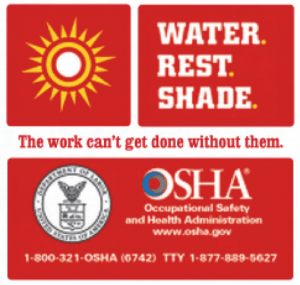When it comes to preventable warehouse deaths and injuries, heat exposure is a top-ranking culprit.
In a 10-year study of heat-related illnesses in the US, the Centers for Disease Control and Prevention (CDC), found there were an average of approximately 618 deaths per year. During a particularly brutal heat wave in 2012, OSHA recorded 4,120 heat-related worker illnesses in one year alone.
Understanding heat-related illness and knowing how to spot the signs are important components to preventing heat-related illness in your warehouse. Use these tips to keep your warehouse employees safe from harmful heat exposure this summer.
What is Heat-related Illness?
Heat-related illnesses are categorized as various medical conditions associated heat exposure. These conditions can be minor annoyances like heat rash and heat fatigue all the way up to life-threatening emergencies such as heat stroke and heat syncope (fainting).

As a general rule, the higher the temperature, the short time it takes to experience the effects of heat-related illness. In fact, it is especially critical to monitor heat indexes in indoor spaces like the warehouse where humidity quickly compound high temps.
What Are Signs of a Heat-Related Illness?
OSHA’s fourth annual Heat-Illness Prevention Campaign encourages employers and warehouse managers to be aware of the signs associated with heat-related illness. With increased awareness and quick action serious medical conditions can be prevented and may even save lives.
- Heat Strokeis the most serious heat-related illness and requires immediate medical attention. Symptoms include: confusion, fainting, seizures, very high body temperature and hot, dry skin or profuse sweating. CALL 911 if a coworker shows signs of heat stroke.
- Heat Exhaustionis also a serious illness. Symptoms include: headache, nausea, dizziness, weakness, thirst and heavy sweating. Heat fatigue, and heat rash are less serious, but they are still signs of too much heat exposure.
Preventing Heat-related Illness Indoors
The following tips are taken from a California-based *training program on Excessive Heat at Work and Preventing Indoor Heat Illness. These materials were created by the Worker Occupational Safety and Health Training and Education Program (WOSHTEP), which is administered by the Commission on Health and Safety and Workers’ Compensation (CSHWC).
Their first wave of prevention in eliminating indoor heat hazards include a series of changes to engineering controls, equipment, machinery, materials or to the work processes. These changes are designed to eliminate, reduce or isolate hazards. Because they aren’t dependent on people and eliminate heat and exposure at the source, they are tremendously effective.
These engineering controls include:
- Installing and maintaining ventilation systems.
- Providing equipment to do a strenuous job more easily (i.e., a pallet jack or conveyor belt).
- Enclosing hot machinery and pipes.
- Installing local exhaust systems to remove heat.
- Installing local ventilation to provide cool air.
- Fixing steam leaks and repairing other broken equipment generating heat.
Another effective way to reduce heat-related illness is to install an industrial warehouse fan. They serve as both an air ventilation system and an air-refreshing unit. What’s more, the steady airflow aids the body’s natural cooling system by helping evaporate sweat from the skin and lowering internal body temps.
In short, if you want to prevent heat-related illness and increase productivity in your warehouse or distribution center, decrease the temperature. Once the temp rises more than about 77 degrees, you risk decreased mental alertness that can lead to errors and potential safety hazards as well as increased risk for some heat-related illnesses.
After all is said and done, investing in the right engineering controls, like industrial warehouse fans, are far less expensive than suffering the potential revenue loss that come from lagging productivity or costly employee injuries and heat-related illness.
*These materials are part of the Worker Occupational Safety and Health Training and Education Program (WOSHTEP). WOSHTEP is administered by the Commission on Health and Safety and Workers’ Compensation (CSHWC) in the Department of Industrial Relations through interagency agreements with the Labor Occupational Safety and Health (LOSH) Program at the University of California, Los Angeles (UCLA), the Labor Occupational Health Program (LOHP) at the University of California, Berkeley, and the Western Center for Agricultural Health and Safety (WCAHS) at the University of California, Davis.
